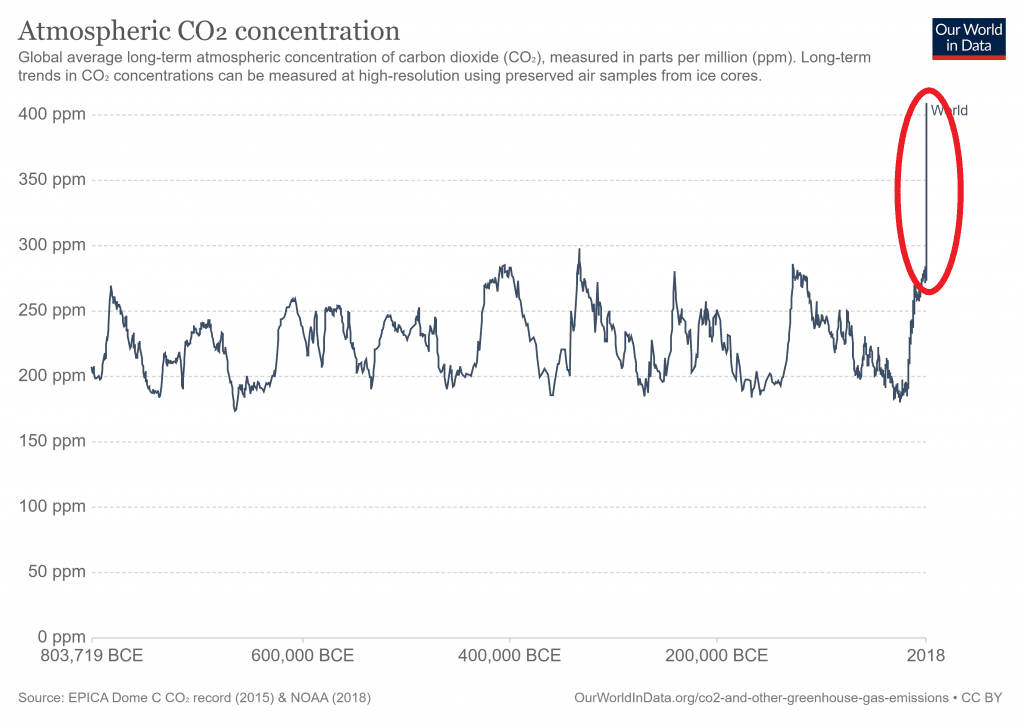We hear and read a lot of things about climate change, greenhouse gas emissions, carbon neutrality, and so on. In the past few weeks, governments and companies have made many promises about climate action. But how are we progressing? Let’s step back from the noise and look at what’s happening in terms of emissions.
We start from the basics.
Human emissions of greenhouse gases are a primary driver of climate change. The first thing we need to have is a basic understanding of these greenhouse gases. When we talk about these gases, we refer mainly to carbon dioxide, methane, nitrous oxide, and chlorofluorocarbons that we add to the atmosphere because of human activities (anthropogenic emissions).
Carbon dioxide (CO2) is a critical greenhouse gas, and we often find it in articles, reports, news – but why? There are several reasons behind that and following you will find the most important ones.
First, the amount of CO2 in our atmosphere. The increase of CO2 concentration started in the industrial era, mainly caused by the use of fossil fuels. Let’s have a look at the numbers.
CO2 Emissions*
Year 1760 =10 million tonnes
Year 1860 = 330.6 million tonnes
Year 1960 = 9330 million tonnes (same as 9.33 billion t)
Year 2019 = 36440 million tonnes (same as 36.44 billion t)
*These are selected annual carbon dioxide (CO₂) emissions from the burning of fossil fuels for energy and cement production (land-use change is not included) as published by Our World in Data based on Global Carbon Project; BP; Maddison; UNWPP.
Second, this dramatic increase happened over a limited amount of time (the past few centuries). It is not only the absolute amount of CO2 that matters, but also how fast this change has been. The chart below shows the atmospheric concentration of CO2 over more than 800,000 years (this is possible by analyzing ice core samples). We can see that the concentration of CO2 was under 300 parts per million (ppm) for a very long time. After the Industrial Revolution, there is a rapid rise in just a few centuries and CO2 concentration reached more than 400 ppm in 2018 (red circle).

Third, CO2 absorbs energy, meaning that when it’s in the air, it traps part of the sun’s heat (which would otherwise escape to space), and this heat is warming our planet. The more carbon dioxide we add into the atmosphere, the warmer our planet becomes. We have already experienced the warmest decade since the late 1800s. And the global sea level has been rising due to the expansion of the ocean and ice melting.
Fourth, CO2 has the characteristic to persist in our atmosphere from hundreds to thousands of years after emission. Even if we stop emitting today – and we are far from it – we will still see the increase of temperature and sea-level rise before the temperature stabilizes. Not more than a month ago, NOAA Research (the U.S. National Oceanic and Atmospheric Administration) announced that “the levels of carbon dioxide and methane continued their unrelenting rise in 2020 despite the economic slowdown caused by the coronavirus pandemic response”. They found that the global CO2 concentration in 2020 was 412.5 ppm (Data provided by NOAA Global Monitoring Laboratory, Boulder, Colorado, USA, https://esrl.noaa.gov). And that’s even when global CO2 emissions in 2020 declined by almost 2 billion tonnes.
Lastly, but not less important, is that CO2 is a by-product of many of our activities. When we make cement, produce electricity, grow crops and livestock farming, transport or ship our food/things from one place to another, drive our car, to name a few, we are also producing CO2.
As anticipated earlier, other greenhouse gases are responsible for changing our climate, such as methane, nitrous oxide, and chlorofluorocarbons. These gases are important as well because they contribute to warming our planet; for example, methane (CH4) has a higher “global warming potential” than CO2 (that means that it traps a lot more heat than CO2, 28 times more if you would like to have a number), but it does not last as long as CO2. It is removed relatively quickly (just over a decade). To account for these other gases (and their characteristics), we combine them into a single measure using the concept of carbon dioxide equivalents (CO2e). ” The global CO2 equivalent in 2018 was about 49 billion tonnes. (Data published by country and sector from the CAIT Climate Data Explorer, and downloaded from the Climate Watch Portal https://www.climatewatchdata.org).
It is helpful to keep in mind these numbers because, thanks to them, we can make calculations and evaluate the significance of what we read every day.
So the next question is: How are we going this year? Where are we?
According to the Global Energy Review 2021 released by the International Energy Agency (IEA), energy-related carbon emissions are estimated to rise by 1.5 billion tonnes in 2021, mainly due to the use of coal to produce electricity. Emerging markets and developing economies now account for more than two-thirds of global CO2 emissions (IEA (2021), Global Energy Review 2021, IEA, Paris https://www.iea.org/reports/global-energy-review-2021 ).
Using the words of Fatih Birol, the Executive Director of the IEA: “This is a dire warning that the economic recovery from the Covid crisis is currently anything but sustainable for our climate.”
Do we have a chance to limit the global temperature rise to 1.5oC (degrees Celsius) if we continue within this trajectory? No, if we continue to emit this amount of greenhouse gases we will not limit the global temperature or sea-level rise. It’s clear and urgent: we need to start cutting our emissions today if we want to have a chance to avoid a climate emergency.
Our growth hasn’t been sustainable, but the reality is waking us up and telling us that we can only continue to grow on this planet if our development is sustainable. A “Development that meets the needs of the present without compromising the ability of future generations to meet their own needs.” (from the Prime Minister Brundtland of Norway in the 1980s)
So when we think about tackling climate change, we also need to think about how countries around the world can develop and prosper in a sustainable way without harming the planet.
Climate change is a complex topic, and there is no single solution to solve this huge (global and local) challenge. However, I believe that we can act and take responsibility for more sustainable choices every day – as a person or community, business leader, or government. If you would like to know more about my blog visit protegoterra.org
Thanks for reading!
If you enjoyed this article, subscribe to Protegoterra’s newsletter.

